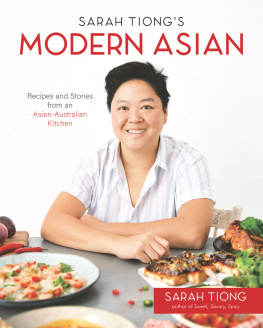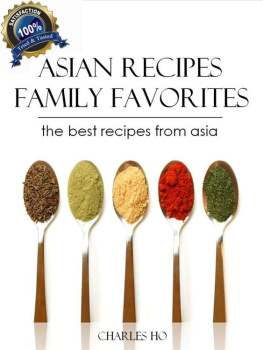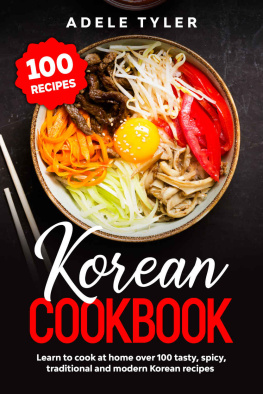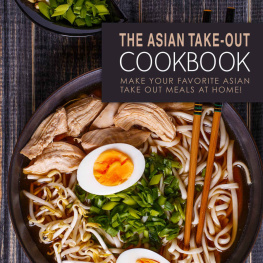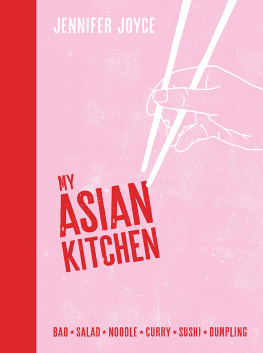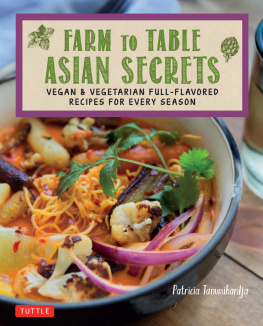Contents
Guide
Recipes and Stories from an Asian-Australian Kitchen
SARAH TIONGS
MODERN ASIAN
SARAH TIONG
author of Sweet, Savory, Spicy
The author and publisher have provided this e-book to you for your personal use only. You may not make this e-book publicly available in any way. Copyright infringement is against the law. If you believe the copy of this e-book you are reading infringes on the authors copyright, please notify the publisher at: http://us.macmillanusa.com/piracy.
DEDICATION
For Mum. You are my heart and home.
May every dish I make share a little of your love, until were together again.
Up until now, Ive kept this pretty private. Just a few months after the conclusion of my last appearance on MasterChef Australia in 2020, I lost my mum. It is the toughest, most painful journey Ive ever embarked on. This book is in honour of her and the lessons she taught me in the kitchen and in the aisles of the grocery stores. Its a book of thanks to the ingredients she raised me on, discovered with me and encouraged me to try at least once. My curiosity, my passion and my commitment are all thanks to the woman she was.
Mum was only a teenager when she left the sticky humidity of Sarawak, Malaysia, and landed in red-brick-lined, skyscraper-dotted, sandy beachspotted Sydney, Australia. She had never lived without her own parents before and had never learnt to cook. Soon, she found herself running her own business seven days a week and raising two kids who seemed to eat like vacuums. Suddenly rice and fried eggs didnt cut it and her babies were begging for spaghetti and meatballs, lasagne, roast dinners and endless snacks that shed never cooked or tasted before. So, what was a busy woman on a budget to do when all she had in her pantry were soy sauce, sesame oil, fish sauce and a little bit of miso? She found inspiration anywhere she could; she took bold guesses and made a few mistakes along the way, but it soon became a glorious creative world of deliciousness and joy.
Its all led to this book; recipes focused on maximum flavour from a staple Asian pantry as an homage to the incredible cuisine my mother devised, with my own modern take on it. The recipes are not authentic or traditional Asian recipesthey are things like spaghetti and meatballs made with miso paste and fish sauce that are the most umamipacked plate of comfort, roast chickens slathered in Thai red curry paste, picnic sandwiches stuffed to the brim with sticky charsiu, pickles and coleslaw. My mother was Chinese-Malaysian. Im Chinese-Malaysian-Australian and that has a huge impact on the food I eat. Layer that with all the nuances of being time poor, having a small budget every day and learning to cook on your own, and you get food that is all about heart and emotion. All the recipes in this book are about innovation and a little left-of-field cooking, without compromising on taste.
This book reflects the way I love to eat and cook. There arent any hard or fast rules, Im not always bound to tradition and, to me, authenticity is subjective. I want flavour, texture, lightness, richness, boldness, subtleness and every nuance in between. I want food that speaks to memories, emotion, curiosity, bravery, fun and drawing the best out of ingredients. As a chef, I fell in love with French and Italian cuisine early on. They felt exotic, elegant and dreamy. The pursuit of technique and process motivated me. But as I developed as a chef, my heart always gravitated home, towards Southeast Asian comfort. But the creative excitement and passion really blossomed when I found ways to play in all fields, borrowing flavours from Southeast Asian cuisine and blending them with techniques and aesthetics of French and Italian cuisine. I hope these recipes surprise and delight you as much as they have for me.
Ive poured a lot of my grief, memories and love into this book. My food comes from humble beginnings but has landed in a very emotional, conscientious place worthy of being my career and passion.

This chapter is your powerhouse of flavour. This is the same pantry my mother kept when I was growing up. Ive inherited the same sauces and condiments, from and so many things in between. From these basic ingredients, the world of possibility is vast. There is no limit to the creativity you can apply to these ingredients. Ill give you a full explanation of the pantry and give you several sauce recipes that are used throughout the subsequent chapters as bases and extra layers of flavour. Use this as a starting point to build your own Asian pantry and get excited by the deliciousness you collect and create.
Chinese Five-Spice Powder
According to traditional Chinese medicine, Chinese five-spice is based on the five elements of fire, water, wood, earth and metal. These elements are manifested in different parts of the body and require careful balance to promote health and energy, hence the creation of this spice mix. The spices are star anise, fennel seeds, Szechuan peppercorns, clove and cinnamon. It is wonderfully aromatic, warm, Christmassy and extremely versatile. Ive used it in sauces, mains and even desserts.
Dark Soy Sauce (Mushroom Flavoured)
The brand my family has favoured most, and one that Ive had the pleasure of working with briefly, is Lee Kum Kee. In particular, I am a huge fan of their mushroom-flavoured dark soy sauce. It adds colour and umami without being as salty as light soy sauce. If you cant find mushroom-flavoured dark soy sauce, simply use any dark soy sauce you can find.
Maggi Seasoning
This is a very savoury sauce I grew up with. We added it to everything from congee and eggs to dumplings and salads. This seasoning is heavy on the salt, but it provides an extreme amount of umami. Its like if light soy sauce and chicken bouillon had a baby, then added MSG to it.
Mirin
This is a sweet sake used to add sweetness and depth to a dish without adding heaviness. Mirin is fantastic for adding sweet aromas to sauces and marinades. By adding mirin, youre essentially adding the sugar from the alcohol, which helps with caramelisation of meats and vegetables.

